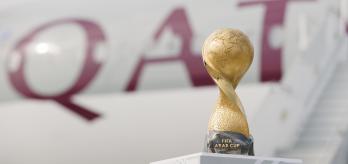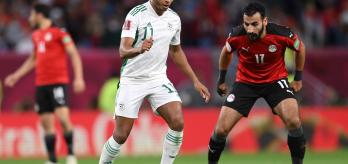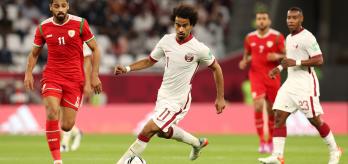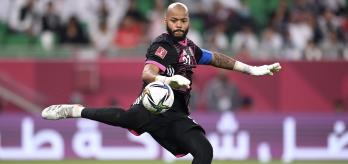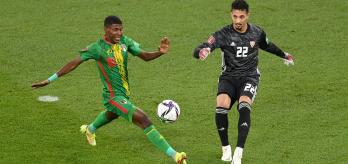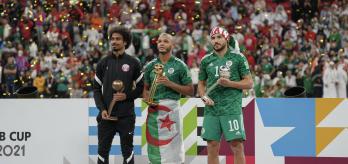From the very first minute of their quarter-final clash with United Arab Emirates, Qatar set the tone for an emphatic first-half performance that saw them go into the interval with a 5-0 lead.
From their own kick-off, Qatar aimed a lofted diagonal pass towards Ahmed Homan. The left wing-back had made a purposeful run down the side-line and won the aerial duel. The ball went into contest and was picked up by UAE right-back Bandar Al Ahbabi. Immediately, Qatar midfielder Abdulaziz Hatem intercepted and won possession high up the pitch.
The next five minutes followed a similar pattern. As UAE attempted to build play, Qatar held a mid block and collectively pushed forward with every sideways and backwards pass until they had UAE back in the territory which enabled the hosts to again employ the high press.
"Their intention was very clear from the very first whistle: try and push UAE back towards their own goal, press them high up the pitch when they could as well, force them into making an early mistake. And they got their reward," noted Technical Study Group expert, Dwight Yorke.
In the sixth minute, Qatar moved in front. From another aggressive high press, they turned over the ball courtesy of the persistence of Almoez Ali, who forced the first of a series of defensive errors. He played inside to Akram Afif, who was tackled before the ball subsequently ricocheted off defender Ali Salmeen and into the net.
"That goal really kickstarted everything else," said Yorke. "The momentum just continued from there. You could see their class, the energy, the balance in the team and UAE really struggled to handle that."
Possession & build-up
By the time the half-time whistle blew, Qatar had scored five goals without reply. But incredibly, they had done so with just 25.8% possession compared to UAE's 71.3%.
Bert van Marwiijk’s side spent 68% of their ball possession in their own third or the middle third of the pitch while attempting to build-up play.
In the first half, UAE received the ball in front of the Qatari team shape 208 times, contrasting greatly with Qatar's 44.
Breaking lines
The efficiency and translation of line breaks to goal-scoring chances in the first half is another interesting feature of the data sets from this game. UAE attempted to break Qatar’s first defensive line 36 times, and attempted to breach their final unit line four times.
In significant contrast, Qatar only attempted 16 line breaks but also had four attempts at breaking their opponent's final unit, one of which directly resulted in a goal being scored. "It’s the best first half I've seen in the competition in terms of the execution. They got their game plan right," said Yorke.
"They were so direct and very precise with their play from back to front. The transition was really good, they just got the ball up to the front two and then got the numbers up to support them, in wide areas and through the middle."
Qatar's press
In a major contrast to their pressing style in the group stage, Qatar's defensive pressure applied in the final third was significantly higher than in their games against Bahrain, Oman and Iraq. Their intention to push on changed the level of intensity against UAE when compared to previous matches in the competition.
Qatar's defensive pressure events in the first half (587) far outweighed those of UAE (370). Because UAE dominated possession, it can be expected that Qatar would execute more defensive actions, but when we assess their pressing actions in relation to the number of passes their opponents have made, the difference in intensity is evident.
They brought much more intensity (0.78) to their pressing actions per opponent pass in the final third in this match against UAE when compared to their group stage games against Bahrain (0.5), Oman (0.55) and Iraq (0.63).
For example, in their first group game vs Bahrain, 0.5 pressure events were registered per opponent pass in Qatar's final third. This means that for every two passes in Bahrain’s defensive third, we would see, on average, one pressing event from a Qatari player.
As the tournament has progressed, Qatar's performance in this area is steadily increasing, with the highest intensity coming against their latest opponents.
Qatar’s press was initiated by their two centre-forwards, Akram Afif and Almoez Ali. Once they engaged, that was the trigger for the rest of the team to anticipate where the next pass would go, with the three midfielders central to the fulcrum of its mechanics. If it went wide to a UAE full-back, the midfielder on that side pressed, while centre midfielder, Karim Boudiaf, was pivotal in how he shifted from side to side, supporting underneath the press while also acting as a central screen.
If the midfielders could not engage due to being locked on centrally or caught narrow on a switch of play, then the wing-backs were also prepared to engage aggressively on the receiving full-back, leaving the centre-back on their side to shift across and cover the space behind.
When we examine the contribution of individual players to the Qatar team press, the highlighted roles of their left and right-sided centre midfielders, Abdulaziz Hatem and Hassan Alhaydos, are quantifiable. This is mirrored statistically, when compared with the receiving pressure faced by UAE’s two key attacking midfielders, Tahnoon Alzaabi and Caio Canedo. Centre-forward Almoez Ali’s role in leading the pressing line is also notable.
"You could see they had worked a lot on this press and had two willing front players who were prepared to do the work and were so well supported by their three midfielders. I was surprised UAE didn’t change their build-up plan earlier, when they could see they were being pressed high," concluded Yorke.
Qatar's victory sets up a semi-final clash with Algeria at the Al Thumama Stadium on Thursday. The other last four clash sees Tunisia face Egypt.











